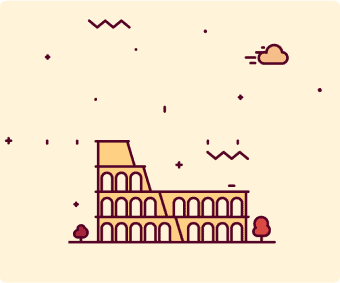Visit the Flavian Amphitheatre
After receiving over 90 million votes for the initiative undertaken by B. Weber, the Colosseum was included in the list of New Wonders of World and was dedicated by the former director general of theUNESCOthe Spanish Federico Mayor: a masterpiece of unquestionable value, loved by Romans and the world. More than seven million tourists visit it every year. Declared a UNESCO World Heritage Site and 'One of the New Seven Wonders of the World', the Colosseum is one of the most important and sought-after historical attractions in the world. The entire area around the Colosseum, from theArch of Constantine at roman forumsis a true open-air archaeological site that is worth seeing at least once in a lifetime. This is why visiting the Colosseum is and will always remain a must for every citizen of the world. The Colosseum is one of the most visited archaeological sites in the world, with an ever-increasing number of visitors. More than 60 million visitors have been estimated in the last 10 years, with records of more than 7,000 per year.
Want to visit the Colosseum?
Buy your entrance tickets for the Colosseumeven before arriving in Rome, is certainly the best way to jumping the queue at the ticket office, get priority on admissions, choose the best experience, tailor it to your needs.
Attention: I skip the line tickets and the guided tours at Colosseum of Rome can sell out well in advance, so it is advisable to booking tickets online in advance to avoid disappointment. It is very difficult to buy tickets on the spot, so get your Colosseum tickets online via our website.
Attention: The most fascinating parts of the Colosseum are thearena and the basementswhich attracts most visitors. Always check if your ticket or tour includes these points of interest!
Guided Tours at the Colosseum, from € 42.00 - Book now
Priority access without access to the basement, from € 18.00 - Book now
Would you like to visit the Colosseum with language guide? Book now
AGREE! Buy Rome City Pass includes combined access to several of Rome's attractions, including the Colosseum and major archaeological sites.
All sold out?
No tickets available?
See the dates of this tour which rarely runs out.
Guided tours
I guided tours of the Colosseum are unique and immersive experiences that take you on a discovery tour of one of the world's most famous monuments. With expert guidance, you will have the opportunity to immerse yourself in the thousand-year history of theFlavian Amphitheatre and discover the hidden secrets of this marvel of antiquity. You will admire the majesty of the building up close, walk through the corridors leading to the seats, visit the dungeons and experience the thrill of standing in a place that has seen epic historical events unfold.
Tourist Cards Rome
La Omnia Card Rome is a card that allows access to some of the city's most famous tourist attractions, such as the Colosseum, the Vatican and the Sistine Chapel. With this card, users can avoid queues and save valuable time, as well as enjoy free public transport and discounts in some restaurants and shops.
La hop-on hop-off card is a tourist service that allows you to explore Rome comfortably on board panoramic buses. With this card, you can get on and off the bus whenever you want at one of the city's many points of interest, such as the Colosseum, the Vatican, Piazza Navona and many more. The card has several options, including tours lasting 24, 48 or 72 hours, and allows you to see Rome's most important monuments without the stress of traffic and parking.
Your visit to the Colosseum
The Colosseum is open every day of the week, with opening hours varying according to the season. During the summer months, opening hours are generally from 9:00 to 19:15, while in the winter months it closes earlier, around 16:30. The last admission is allowed about one hour before closing time.
Booking tickets for the Colosseum online is highly recommended, especially during the high season. This allows you to avoid long queues and guarantee access to one of Rome's most visited attractions. Booking online also allows you to choose the time of your visit, making your experience more organised and enjoyable.
Other Monuments
Take your time to visit. The Colosseum, Palatine and Roman Forum cover a lot of space and with so many crowds of tourists around, it can take quite a few hours to get through everything you want to see.
The Name of the Colosseum
There are many myths and legends about the colosseum and we treat them as such. by researching, reading and listening, we have collected a few curiosities from the past and a few questions from the present. the first thing to deal with is definitely the name colosseum and when and why it started to be used instead of amphitheatre flavio.
The origin is not certain, many like the idea that the name 'colosseum' comes from the 'colossus' of Nero, an enormous statue (according to others of Heliogabalus in the guise of the sun god), 30 m high, which stood next to the amphitheatre roughly where the entrance to the metro station is today. others think, simply, that the name emphasises the (colossal) size of the circus itself, and another theory traces it back to the site of the amphitheatre, in ancient times 'collis isei' from a temple of isis that stood on Mount Opium and gave its name to the district, known as 'iseo'.
There is also a curious legend according to which the colosseum was a temple inhabited by demons. the priests of this temple at the end of each ceremony addressed the followers with the question: "colis eum?" (do you worship him? i.e. do you worship the leader of these demons? referring to the devil); hence the name of the monument, coliseum.
The story of the demons lasted for a long time as even benvenuto cellini mentions it in one of his stories, where he narrates that one night he went to the colosseum to witness the demonic manifestations with his friend agnolino gaddi, and the latter was so frightened that he "made a hystrombazzata di coregge con tanta abundanzia di merda, la quale potette molto più che la zaffetica" (a lot of shit, which could do much more than the zaffetica) and all the devils fled in a fury. it seems that, starting in the 8th century, the Flavian amphitheatre took on the name colyseus for the first time in an epigram by the venerable Bede:
quamdiu stabat colyseus stabit et roma; quamdo cadet colyseus cadet et roma; quamdo cadet roma cadet et mundus. as long as the colosseum stands, so will Rome; when the colosseum falls, so will Rome; when Rome falls, so will the world.
The Structure of the 'Colossus' of Rome
Roman buildings are world-famous for their solidity and ingenuity. The architecture of the colosseum is the subject of study of several experts. It is a complex and articulated structure, solid and harmonious, and even today, some mechanisms used during the spectacles, for example the flooding during the ludi with boats, are still not fully explained.
The Roman engineers took the Greek theatre as a model. in the past, in fact, the verticalisation of the building was necessary to contain the majority of the spectators as close to the stage as possible.
In the construction of the Greek theatre, they took advantage of the natural slope of the hills where it was built, but the genius of the Roman engineers was to unite the supporting structures of two theatres to form a theatre in the round (amphitheatron) that could hold twice as many spectators.
All this was also made possible by the evolution of building techniques, the experience gained over the years, and new and revolutionary building materials.
One fact is certain, genius, experience and technology combined to create the amphitheatrum flavium, an astonishing theatre that hosted a huge crowd around a great spectacle.
A full 52 metres high, the equivalent of a 17-storey structure, the Colosseum manages to stand thanks to the brilliant construction technique of the arch, the architectural element used by the Romans to build aqueducts. As many as 80 arches arranged on four floors create the famous elliptical shape of the Colosseum, which could hold as many as 70,000 spectators.
About the Colosseum
Dimensions... colossal
The Colosseum is an elliptical building 189 metres long and 156 metres wide, covering an area of 24,000 square metres with a height of more than 48 metres. It has about 80 entrances and could accommodate about 70,000 spectators.
Work in progress.
It took just over five years to build it: from 75 to 80 AD. For the outer wall alone, more than 100,000 cubic metres of travertine were used.
A name, a mystery.
In the beginning it was called Flavian Amphitheatre (it was built by Vespasian and Titus of the Flavian dynasty, ed). The name 'Colosseum' arrived only in the Middle Ages: the most accredited theory is that it is so called because it was built near the statue of Nero's 'colossus' that stood a few metres from the amphitheatre. Others say it derives from the location, because it stands on a hill where a temple to Isis once stood (hence Collis Isei). But there is also a black legend that it was formerly a pagan temple, where the devil was worshipped. And at the end of each ceremony, the priests asked the worshippers: "Colis Eum?" ("Do you worship him?").
Without the Colosseum, many historical buildings would not exist.
The marble of the facade and some interior parts of the Colosseum were used for the construction of St Peter's Basilica and also for civil buildings such as Palazzo Barberini. Having fallen into neglect, for a long time the amphitheatre was in fact used as a source of building materials. This was the case until the 18th century, when love for the ancient remains of Rome returned. It is estimated that in the course of time only one third of the original construction remained.

OnLine Tickets and Information
When it comes to obtaining tickets for the Colosseum, there are a number of options one can consider. Book your ticket online is often the easiest choice for many tourists because it allows you to jumping the queue and eliminates long waiting times when purchasing a ticket from the ticket office. For travellers who have not planned ahead, there are the dreaded queues at the ticket offices. But don't be fooled by the fact that the desk outside the Colosseum is the only place you can buy a ticket. The queues here are long so if you don't have time to wait you can always buy a tour online taking advantage of a guided tour.
Quotes About the Roman Colosseum
"... some beggars, crouching under the ruined vaults, had lit a fire on the bare earth, and a gentle wind was just pushing the smoke towards the arena... we stood by the gate, observing. shone, high, the moon; and little by little the smoke, which escaped through the walls, the cracks, the openings, was illuminated by it like a mist."
J.W Goethe
1786/7 travelling in italy
"I see its immense sea in tiers covered by a crowd of Romans; here are the senators; here is the purple veil spread over the crowd, whose murmur sounds like that of a sea in the distance; then the murmur changes to cries of joy, wild cries, and this arena so calm and silent today appears to me tinged with blood..."
Eugène Viollet-le-Duc
1836 Lettres D'Italie
"... Under our feet we have, in the moonlight, the Colosseum, symbol of the colossal history of the empire, almost an enormous marble basin in which this Rome has collected the blood of the whole world. On the other side the eye spreads over the eternal city, thousands of lights shine, but the city is silent..."
Gregorovius
1858 On Walks Through Italy
The Colosseum by day, by moonlight, by torchlight and in all kinds of light is as beautiful as it is terrible.
charles dickens
1844-45
The Colosseum is like the skull of Argos: in empty circles
clouds swim over him, a reminder of the ancient flock.
iosif brodsky
1974
"Rome will exist as long as the Colosseum does; when the Colosseum falls, so will Rome; when Rome falls, so will the world. "
Venerable Bede
672 AD
Advice and info
The Colosseum is open every day, with varying hours depending on the season. During the summer, the hours are from 9:00 to 19:15, while in the winter months it closes around 16:30.
The average duration of the visit is about 1-2 hours, depending on how much time you wish to spend exploring.
Visiting the Colosseum is one of the main activities in the city of Rome, which is why it is easy to find long queues at the site to get tickets, especially in the middle of the day. Remember that Rome is in all months of the year taken by storm by tourists. Even if you try to go early in the morning or late in the afternoon to avoid long lines, you risk waiting for a long time (the average wait lasts between 45 and 60 minutes). One of the best ways to avoid long queues is to buy your tickets online, choosing between priority entrance and guided tours.
The best time to visit the Colosseum is in the morning at the time of opening, between 8.30 and 10.30 am, or in the late afternoon between 5 and 7 pm. It takes at least two hours, approximately, to visit.
Here are some options for buying tickets to visit the Colosseum, one of the most popular attractions in Rome and all of Italy. In some of these options you also have the possibility to visit the nearby Roman Forum and Palatine. The Roman Forum and Palatine, in fact, are located right in front of the Colosseum, and to see them from the outside without being able to enter them would be a real shame. So not only priority entrance and skip-the-line tickets, but real experiences created ad hoc.
Yes, the Colosseum is accessible with prams and pushchairs, but some areas may have restricted access.
Yes, the Colosseum is accessible with prams and pushchairs, but some areas may have restricted access.





